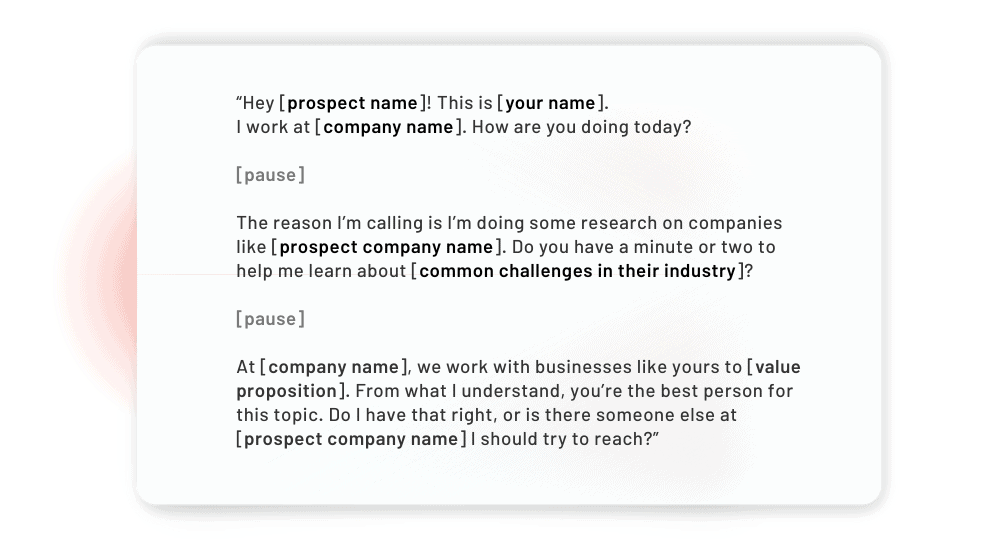

Cold calling is a unique and proactive sales strategy, unlike any other form of marketing outreach.
At its core, cold calling is about initiating conversations with potential customers (prospects) who have had no prior interaction with the salesperson or the product offered. This distinctly unsolicited approach requires finesse, as the aim is to transform a call out of the blue into a promising business opportunity.
Cold calling stands apart from warm leads or customer referrals, as it targets individuals based solely on research and intuition without an established relationship.
Prepare to uncover the essence of this time-honored yet often misunderstood sales technique, as we explore how to confidently navigate the realm of cold calling and connect with prospects effectively.
Why is Cold Calling Important for B2B Selling?
Cold calling represents a vital tactic for direct interaction with potential clients. While often perceived as an older method in the digital age, its significance remains substantial, which is why 82% of buyers accept sales meetings when salespeople actively reach out to them.
With a cold calling approach to business growth in place, you have the opportunity to do the following:
Have a Direct Line to New Prospects
Initiating a conversation through cold calling is more than just a pitch; it’s about opening a dialogue with new prospects. This method allows sales professionals to reach out to potential clients who might not be aware of their solution. By presenting your offer directly, you bypass the noise of crowded digital channels and make an immediate impact.
Establish Personal Connections With Prospects in the Sales Cycle
Building personal connections early in the sales cycle is a cornerstone of successful sales strategies. A cold call provides the unique opportunity to establish rapport and grasp the prospect’s needs in real-time. Personalized communication fosters trust and can significantly influence the decision-making process.
Accelerates Lead Generation and Sales Pipeline Development
Cold calling is intrinsically linked to lead generation and the development of a healthy sales pipeline. By proactively reaching out to potential leads, cold calls help fill the sales funnel with opportunities for conversion. This proactive outreach is essential for maintaining a consistent flow of leads, ensuring a robust pipeline, and ultimately contributing to the business’s growth and revenue.
Best Ways to Initiate a Cold Call
Cold calling can be a daunting task, but with the right techniques, it becomes an effective tool in your sales arsenal. Whether you are new to sales or looking to refine your approach, these strategies will help you make successful cold calls.
To initiate a cold call that captures attention and sets the tone for a potential sale, consider these strategies:
- Prepare an Opening Statement: Have a clear and concise opening ready that introduces who you are and the purpose of your call without sounding scripted.
- Practice Active Listening: Show genuine interest in the prospect’s response. Active listening can help you tailor your pitch on the fly.
- Maintain a Positive Attitude: A positive demeanor can be contagious and helps in building rapport with the prospect.
How to Personalize Your Cold Calls With Research
Understanding your prospect is key to personalizing the conversation and making a connection. Here’s how research can play a part:
- Research The Prospect: Utilize LinkedIn profiles, company websites, and industry news to gather information about the prospect and their business.
- Find Common Ground: Use your research to identify points of connection, such as shared interests or mutual contacts.
- Customize Your Pitch: Tailor your message based on your findings to show that you have taken the time to understand their unique challenges and needs.
Remember to Engage Your Prospect and Showcase Value
Your ability to engage the prospect and demonstrate the value of what you’re offering is crucial for setting the stage for further discussions. Here’s how you can achieve that:
- Ask Insightful Questions: Inquire about their current challenges and goals. This not only shows interest but also provides valuable information to align your pitch with.
- Present Solutions—Not Products: Frame your product or service as the answer to a specific problem or goal mentioned by the prospect.
- Set a Clear Next Step: Before ending the call, propose a clear next step, such as scheduling a follow-up call or sending over additional information, to continue the dialogue.
Incorporating these techniques into your cold calling strategy allows you to increase your chances of success and turn cold leads into warm prospects ready for further engagement.
Understanding the Impact of Crafting Cold Call Scripts
The role of cold calling scripts is pivotal in ensuring that a sales call flows smoothly. Scripts function as a conversational roadmap, helping sales reps navigate from the opening lines to the final pitch. While the necessity of a script is clear, it’s equally important to maintain a level of spontaneity. The script should serve as a guide rather than a set text, allowing salespeople to express themselves naturally and engage in genuine dialogue.
Here’s an example script we use for our client to introduce the conversation to ensure we’re speaking with the right decision-maker:
Once cold callers have the right decision-maker on the phone, it’s time for the pitch.
Below, we offer a sample cold script that incorporates the key elements of our product or service, yet leaves room for personalization and adaptation:
- Greeting: “Hello [Prospect’s Name], this is [Your Name] from [Your Company]. How are you doing today?“
- Introduction and Value Proposition: “I’m calling because we’ve recently launched a new product/service that is designed to [briefly describe the primary benefit or problem it solves].”
- Probing Questions: “I’m curious, how do you currently handle [issue related to your product/service] at [Prospect’s Company]?”
- Addressing Potential Need: “Many of our clients were facing similar challenges and have found our solution considerably effective. Would you be open to exploring how our solution could help you as well?“
- Call-to-Action: “Can I schedule a brief 20-minute call next week for a deeper dive? You’ll get a clear picture of how we can specifically assist you with [restate key benefit].”
While scripts provide a structure, it is essential to adapt the wording to match your natural speaking style. This approach helps build trust with your prospects, making them more receptive to your message. Remember, a successful cold call is a blend of preparation and genuine engagement.
For the complete cold call script that our outsourced BDRs use for lead generation, download our free, exclusive guide full of our industry-leading insights.
Step-by-Step Guide for Cold Call Preparation
Whether it’s your first time hopping on the phone or you need a refresher, preparation is key. Even the most skilled sales professionals need to prepare before picking up the phone. Proper preparation for a cold call can significantly enhance your confidence and increase the likelihood of a successful outcome. Here’s how to lay the groundwork for an effective cold call strategy:
- Research Your Prospect: Before you dial, spend time understanding your prospect’s business, industry challenges, and potential needs. This knowledge will help you tailor your conversation and show genuine interest in their problems.
- Define Your Objective: Clearly define what you aim to achieve with the call. Whether it’s scheduling a meeting, gathering information, or making a sale, having a goal in mind will guide the conversation.
- Prepare Your Script: While you don’t want to sound robotic, having a script can help you stay focused. It should include a compelling opening line, a value proposition, and potential questions and answers.
- Practice Your Pitch: Rehearse your script until it feels natural. This will help reduce anxiety and make your delivery more confident and convincing.
- Set Up Your Workspace: A clutter-free and organized workspace can minimize distractions and help maintain focus during your calls.
- Check Your Tech: Ensure your phone and any other technology you’ll be using are functioning properly. Good sound quality is essential for clear communication.
- Analyze Competitors: Understand what your competitors are offering. This insight helps you to position your product or service more effectively.
- Know Your Product: Be prepared to answer detailed questions about your product or service. Deep product knowledge can build credibility and trust.
Remember, preparation is your best ally in cold calling. By thoroughly preparing, you not only increase your confidence but also demonstrate to potential customers that you value their time and business.
Skip the cold call preparation and put it in the hands of the professional outsourced BDRs at Abstrakt. We use a proven cold calling and email strategy to help B2B companies engage more leads and get more sales meetings.
Learn more about our Outbound BDR solution.
How to Overcome Sales Objections in Cold Calling
Even the most experienced sales professionals encounter objections during cold calls. The key to success lies not only in the presentation of your pitch but also in how you handle these inevitable challenges. Below, we explore common objections and provide strategies to skillfully navigate these conversations.
- “I’m not interested“: Acknowledge their stance and ask open-ended questions to explore underlying reasons for their disinterest. Often, there’s an opportunity to provide more information that could pique their interest.
- “We’re happy with our current service“: Compliment them on their decision and inquire about any pain points they experience. Sometimes, the door is open to discuss how your offer could provide additional value.
- “Now is not a good time“: Empathize with their busy schedule and ask when they would be open to a brief conversation. This shows respect for their time while keeping the opportunity alive.
- “It’s too expensive“: Understand their budget concerns and redirect the conversation to the value and ROI that your product or service can bring to their business.
Always Actively Listen to the Prospect
Active listening is essential when managing objections. By carefully hearing out the prospect’s concerns, you can tailor your responses to their specific needs and pains. This approach demonstrates that you value their opinion and are interested in finding a solution rather than just making a sale.
Pro tip: If the prospect keeps mentioning they are worried about falling behind/scared, try discussing things happening in the space or for their competitors, as “fear-based marketing” can sometimes push others over the edge.
Respond to the Prospect with Empathy
Empathy is a critical component when overcoming objections. It involves more than understanding a prospect’s words; it’s about grasping the emotions behind them. Address their concerns with genuine care and propose solutions that align with what truly matters to them.
Overcoming objections is not about winning an argument, but rather about building a relationship founded on trust and understanding. With these strategies, you’ll be well on your way to turning objections into successful sales conversations.
Read our blog here for more insight into common sales objections, and how to overcome them effectively.
Complimenting Cold Calling With Other Lead Generation Strategies
What is cold calling in the context of lead generation strategies? It’s a proactive approach to directly engage with potential customers. But it’s important to recognize that cold calling is just one tool in a multi-faceted lead generation toolkit. In today’s digital age, it’s critical to employ a mix of strategies to maximize your outreach potential and generate leads effectively.
Cold calling works best when used alongside other lead generation methods. By integrating it with a diverse range of tactics, businesses can create a robust and resilient lead generation engine. This multifaceted approach not only helps in reaching a broader audience but also caters to different preferences, increasing the chances of converting prospects into clients.
- Email Marketing: Use insightful and personalized email campaigns to warm up your leads before calling them.
- Content Marketing: By providing valuable content, you attract potential clients who are interested in your industry, which can make calls more receptive.
- Social Media: Engage with leads on social platforms to create a rapport that can be deepened with a cold call.
- SEO and SEM: Drive traffic to your website with targeted search engine strategies, where you can then capture leads to be reached out to by phone.
- Networking Events: Participating in industry events and webinars can result in strong connections that you can follow up on with cold calling.
While cold calling can be incredibly effective, blending it with these methods creates multiple touchpoints with prospects, reinforcing your message and brand. Therefore, embracing a holistic approach to lead generation that includes both direct and indirect methods is essential for a sustainable and successful sales strategy.
What are the Pros and Cons of Cold Calling?
Cold calling can be a polarizing strategy in the realm of B2B sales, stirring up varied opinions on its effectiveness and efficiency. While some consider it an outdated technique, others harness it as a powerful tool to reach potential clients. Here, we delve into the merits and drawbacks of cold calling, providing you with a comprehensive understanding to make informed decisions for your sales strategy.
Advantages of Cold Calling
- Direct Customer Engagement: Cold calling facilitates immediate interaction, enabling sales reps to directly engage potential clients and adjust their pitch in real-time based on responses.
- Quick Feedback: Salespeople can gain instant feedback from prospects, allowing for agile adjustments to sales approaches and strategies.
- Human Touch: Personalized communication can build rapport and trust that electronic means may struggle to achieve, still making cold calling an important element in a multi-channel outreach approach.
- Market Learning: Engaging with a variety of customers provides valuable insights into market needs, and reactions to offers and can inform both product development and sales approaches.
Disadvantages of Cold Calling
- Resource Intensive: A considerable investment of time and effort is required for cold calling to be effective, which can deter businesses with limited resources.
- Potential Rejection: Sales reps must be prepared for, and able to handle, frequent rejections and the impact this could potentially have on morale.
- Regulatory Hurdles: Evolving regulations on unsolicited calls mean businesses must remain vigilant to stay compliant and avoid penalties.
Amidst the contentious debate on cold calling, the reality is that when executed with skill and integrated into a holistic sales strategy, it can be surprisingly effective, making it a practice worth considering but also worth approaching with a balanced perspective.
Not sure if cold calling is right for your business? Read our blog here to explore some alternatives to cold calling.
Cold Calling vs. Warm Calling: What’s the Difference?
Understanding the difference between cold calling and warm calling is pivotal for choosing the right approach to your sales strategy.
Cold calling is the practice of reaching out to potential customers without any prior contact, often leading to a more uphill battle in building rapport. In contrast, warm calling is the process of contacting prospects who have engaged with your company in the past, giving you a warmer reception due to prior interaction or interest.
When to Use Each Method
Cold calling is often used to expand the customer base, tap into new markets, or introduce new products. It’s a valuable tool to cast a wide net and explore uncharted territories in your market. On the other hand, warm calling is generally more effective in progressing an existing lead through the sales funnel—when a prospect has demonstrated interest through actions such as downloading a white paper, attending a webinar, or prior purchases.
Determining its Effectiveness and Ability to Cultivate Relationships
- Cold Calling: This can be challenging and requires skill to break the ice and build trust from a standing start.
- Warm Calling: Tends to have higher conversion rates, as the initial relationship exists, and the conversation is more about nurturing and persuading.
Both cold and warm calling have their places in a comprehensive sales strategy. Cold calling is key to outreach and acquisition, whereas warm calling focuses on relationship cultivation and conversion. The decision on when to use each depends on your business objectives and the current phase of your relationship with a prospect.
Cold Calling Best Practices
For sales professionals looking to refine their cold calling strategies, it’s essential to blend skill with etiquette to ensure successful outcomes. Following these best practices can significantly improve the cold calling experience for both the salesperson and the prospective client.
- Research Your Prospect: Before making the call, ensure you have a good understanding of the prospect’s business, challenges, and potential needs. This will allow you to tailor your conversation and make a more compelling pitch.
- Practice Active Listening: Pay close attention to the prospect’s responses and concerns. Active listening builds rapport and trust and can guide your conversation to address their specific pain points.
- Keep Calls Concise: Respect the prospect’s time by keeping your call focused and to the point. Craft a clear, concise message that communicates value without overwhelming the listener.
- Use a Friendly, Confident Tone: Your voice is the first and most direct impression you make on a call. Speak clearly, exude confidence, and maintain a friendly tone to keep the prospect engaged.
- Handle Rejections Professionally: Not every call will be a success. Respond to rejections with professionalism and politeness, thanking the prospect for their time.
- End with a Clear CTA: Whether it’s a follow-up call, an email, or a scheduled meeting, conclude your call with a clear call to action to maintain momentum in the sales process.
Get exclusive industry-leading insight into the latest cold calling best practices written by our high-performing BDRs by downloading this free guide!
How Can CRMs Enhance Cold Calling Efforts?
When it comes to enhancing efficacy and results in cold calling, the use of Customer Relationship Management (CRM) systems can be a game-changer. CRM tools assist sales professionals in streamlining their outreach efforts, enabling them to focus on what they do best—selling.
Streamlining the Cold Calling Process
A CRM system is indispensable when it comes to managing large volumes of contacts and ensuring that each cold call is as personalized and informed as possible. By organizing prospect information in a centralized database, sales teams can access full contact histories, notes from previous interactions, and important personal details that help tailor conversations to individual prospects.
- Efficient call scheduling and follow-ups are facilitated by CRM software, making sure no lead falls through the cracks.
- With CRM data, you can segment your leads, categorize them based on potential interest levels or demographics, and prioritize your calling list accordingly.
- Script templates and role-specific insights within a CRM allow sales reps to respond on the fly with accurate and helpful information.
Leveraging Data for Better Calls
The true power of a CRM in the realm of cold calling lies in the ability to track customer interactions and derive actionable insights. Not only does tracking conversations help create a more personalized experience for each prospect, but it also provides data that can be analyzed to refine sales strategies.
- Recording the outcome of calls, noting down specific objections, and gauging customer interest helps refine cold calling scripts and approaches.
- Using CRM analytics, salespeople can identify trends and patterns that reveal the most effective times to call, successful call lengths, and the common traits of receptive prospects.
- Over time, this data accumulation forms a powerful resource for forecasting sales, enhancing performance, and tailoring future marketing campaigns.
Leveraging a CRM system can transform cold calling from a shot in the dark to a strategic, data-driven component of your sales process. It not only optimizes the caller’s time and efforts but also results in better experiences for prospects and potentially higher conversion rates.
Are you sure you’re using your CRM to its fullest potential? Read this blog to gain more insight into the role CRM plays in lead generation.
Understanding Cold Calling Laws and Compliance
Navigating the legal landscape of cold calling is crucial for businesses to operate responsibly and ethically. Compliance with regulations not only helps avoid legal pitfalls but also preserves your company’s reputation. Here’s what you need to know:
Do Not Call Registry and Cold Calling Regulations
In many countries, governments have established rules to protect B2C consumers from unsolicited calls. In the United States, the Do Not Call Registry allows individuals to opt out of receiving B2C telemarketing calls. It’s imperative for businesses to check this registry before making cold calls to avoid legal consequences and hefty fines. Additionally, various laws, such as the Telephone Consumer Protection Act (TCPA), set the framework for what is permissible.
Staying Compliant While Cold Calling
Compliance is more than just a legal requirement; it’s about respecting potential customers. To stay on the right side of the law:
- Always cross-reference the Do Not Call Registry before dialing.
- Understand and respect call curfews; many regions restrict calling to certain hours.
- Provide a clear opt-out mechanism in each call for receivers not interested.
- Maintain accurate records of consent and requests to be removed from your call list.
- Train your sales team on the nuances of legal compliance in cold calling.
Whether you have a B2C or B2B cold calling strategy, your cold callers must be informed of legislation changes to ensure your business practices remain up to date. This can include general cold calling legislation or state cold calling laws. Remember, the goal of cold calling isn’t just to sell – it’s to build lasting relationships based on trust and respect.
Cold Calling Metrics and KPIs to Track
Understanding and analyzing the right key performance indicators (KPIs) is crucial for gauging the success of your cold calling efforts. Tracking these metrics not only assesses the effectiveness of sales strategies but also helps optimize future campaigns for better results. Here are the essential cold calling metrics that businesses need to monitor closely:
- Call-to-Appointment Ratio: This metric reveals the efficiency of calls in generating appointments. It is calculated by dividing the number of appointments set by the total number of calls made.
- Conversion Rate: Conversion rate is a critical measurement that tells you the percentage of calls that turned into confirmed sales. It indicates the potency of your pitch and approach.
- Average Call Duration: This metric offers insights into how engaged potential clients are during calls. Longer calls can imply more interest or complex negotiations, while shorter calls may point towards disinterest or efficient communication.
- Lead Response Time: The speed at which a sales rep responds to a lead can significantly impact conversion rates. Quicker response times are often associated with higher success.
- Cost per Call: Understanding the cost involved per call helps in budget allocation and measuring the overall efficiency of the cold calling campaign.
- Revenue per Call: This KPI measures the average revenue generated from each call, regardless of the call’s outcome. It is a vital metric for determining the financial effectiveness of your cold calling efforts.
By educating yourself on tracking these metrics, you can refine your cold calling strategies for continual improvement and greater sales success.
No Matter How Advanced Your Cold Callers are, Always Encourage Cold Calling Training Opportunities
Even the world’s top athletes never stop training, and neither should your team of cold callers. Cold calling is an art that often requires fine-tuning and a strategic approach to truly excel. To ensure your sales team is poised for success, investing in training and coaching is essential. But why is it so crucial, and how can it revolutionize your team’s performance?
Transforming Potential into Performance
Training programs and personalized coaching can be a game-changer by enhancing your team’s skill set. Here are key areas that targeted training can improve:
- Communication Skills: Articulate the value proposition clearly and confidently to hold the prospect’s attention.
- Objection Handling: Equip your team with the ability to navigate through common objections and turn them into opportunities.
- Call Strategy: Understand the importance of timing and call structure to maximize engagement.
- Psychological Insights: Gain an understanding of customer psychology to better anticipate needs and tailor the conversation.
- Performance Analysis: Use feedback and analysis to continuously improve call techniques.
Coaching for Consistent Success
Beyond group training sessions, personalized coaching can give your sales team members the one-on-one attention they need to overcome individual hurdles and fine-tune their approach. By investing in the development of your team’s cold calling capabilities, you significantly boost your success rates and the overall efficiency of your sales operations.
The investment in training and coaching ultimately equates to an investment in your company’s future. A well-trained sales team is the driving force behind a robust sales pipeline and sustained business growth. Take the first step towards empowering your team and watch as the confidence in their cold calling abilities grows, leading to more deals closed and stronger customer relationships forged.
Key Takeaways
Cold calling is (and always will be) one of the best ways to fill your pipeline, get more sales meetings, and secure more sales. While the concept of cold calling may be simple, the art of practicing it is complex. When you hire an outsourced cold calling company, you have access to cold calling team that can effectively convert qualified prospects into sales opportunities.
Abstrakt is a leading B2B appointment company that uses the power of cold calling to introduce, qualify, and nurture highly qualified leads for your business’s sales pipeline. Contact us today if you want to optimize the way your company approaches cold calling!






